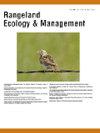管理美国林业局放牧分配的灵活性
IF 2.4
3区 环境科学与生态学
Q2 ECOLOGY
引用次数: 0
摘要
美国西部的许多牧场主在牧场环境中经营,其特点是水和饲料的季节性和年度波动,反复出现的干旱,入侵植物的蔓延,野火的增加,温度的升高,放牧季节的变化以及捕食者的存在。预计气候变化将加剧这些特征。灵活的放牧管理可以促进对西部牧场的适应,同时满足所需的资源条件,包括在联邦土地上,成千上万的西部牧场主在一年中的至少部分时间里放牧牲畜。为了研究目前促进美国林业局管理的联邦放牧分配灵活性的策略和机会,我们对美国西部(林务区1-6)的机构牧场管理专家进行了调查。我们收到了来自53个国家森林和草原单位的129个人的回复。我们发现,许多支持灵活放牧管理的做法至少在一些单位已经在使用,而管理林务局土地上放牧的法律和政策被认为是对灵活性的一个小限制。期望的主要政策变化是能够增加使用国家环境政策法(NEPA)对牧场改善项目的分类排除。调查答复者认为,增加放牧管理灵活性的主要障碍来自林业局内部。其中最突出的是预算和人员的限制、《国家环境法》程序、缺乏生态监测能力以及害怕诉讼。管理人员提出了克服这些障碍的多种想法,同时强调需要增加预算和人员配置,以执行灵活的管理办法。我们发现,在林业局范围内加大对牧场管理项目的投资和优先级,有助于解决项目能力不足的问题,并缓解对分配地灵活放牧管理的一些限制。本文章由计算机程序翻译,如有差异,请以英文原文为准。
Managing for Flexibility on U.S. Forest Service Grazing Allotments
Many ranchers in the western U.S. operate in a rangeland environment characterized by seasonal and annual fluctuations in water and forage, recurring drought, spreading invasive plants, increased wildfire, warming temperatures, shifting grazing seasons, and predators. Climate change is predicted to exacerbate these characteristics. Flexible grazing management can facilitate adaptation to western rangelands while meeting desired resource conditions, including on federal lands, where thousands of western ranchers graze livestock for at least part of the year. To investigate current strategies and opportunities for promoting flexibility on federal grazing allotments managed by the U.S. Forest Service, we employed a survey of agency rangeland management specialists in the western U.S. (Forest Service Regions 1-6). We received responses from 129 individuals across 53 national forest and grassland units. We found that numerous practices supporting flexible grazing management were already in use on at least some units, and that laws and policies governing grazing on Forest Service lands were perceived as a minor constraint to flexibility. The primary policy change desired is the ability to increase use of National Environmental Policy Act (NEPA) categorical exclusions for rangeland improvement projects. Survey respondents perceived the main barriers to increasing flexibility in grazing management as being internal to the Forest Service. Prominent among them are budget and staffing limitations, the NEPA process, lack of capacity to conduct ecological monitoring, and fear of litigation. Managers offered multiple ideas for overcoming these barriers while emphasizing the need for increased budgets and staffing to implement flexible management approaches. We found that greater investment in and prioritization of the Rangeland Management Program within the Forest Service could help address lack of program capacity and alleviate some constraints to flexible grazing management on allotments.
求助全文
通过发布文献求助,成功后即可免费获取论文全文。
去求助
来源期刊

Rangeland Ecology & Management
农林科学-环境科学
CiteScore
4.60
自引率
13.00%
发文量
87
审稿时长
12-24 weeks
期刊介绍:
Rangeland Ecology & Management publishes all topics-including ecology, management, socioeconomic and policy-pertaining to global rangelands. The journal''s mission is to inform academics, ecosystem managers and policy makers of science-based information to promote sound rangeland stewardship. Author submissions are published in five manuscript categories: original research papers, high-profile forum topics, concept syntheses, as well as research and technical notes.
Rangelands represent approximately 50% of the Earth''s land area and provision multiple ecosystem services for large human populations. This expansive and diverse land area functions as coupled human-ecological systems. Knowledge of both social and biophysical system components and their interactions represent the foundation for informed rangeland stewardship. Rangeland Ecology & Management uniquely integrates information from multiple system components to address current and pending challenges confronting global rangelands.
 求助内容:
求助内容: 应助结果提醒方式:
应助结果提醒方式:


